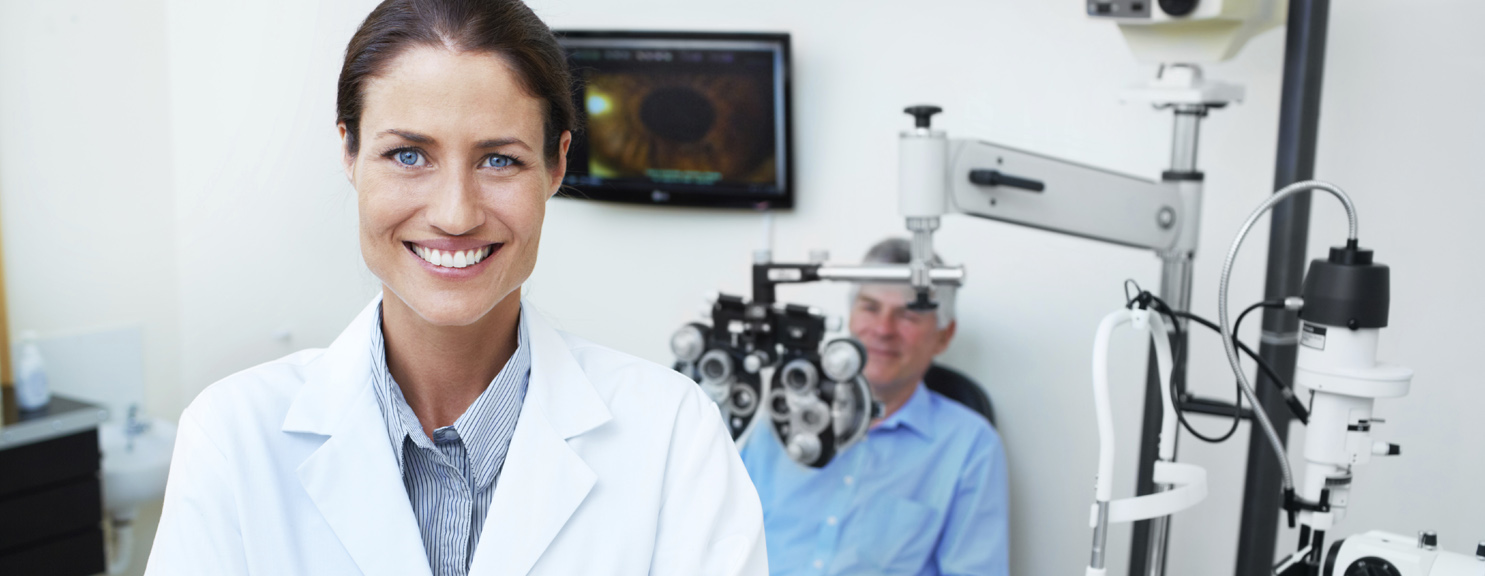What Do Optometrists Do?
Optometrists, also known as doctors of optometry, or ODs, are health care professionals who specialize in vision and eye care, but are not medical doctors. They examine people’s eyes to diagnose vision problems, such as nearsightedness and farsightedness, and they test patients’ depth and color perception and ability to focus and coordinate the eyes. Optometrists may prescribe eyeglasses or contact lenses, or they may prescribe or provide other treatments, such as vision therapy or low-vision rehabilitation. Optometrists may also provide patients with preoperative and postoperative care for cataract, laser vision correction, and other eye surgeries.
Optometrists also test for glaucoma and other eye diseases and diagnose conditions caused by systemic diseases such as diabetes and high blood pressure, referring patients to other health practitioners as needed.
For more information, go to: http://www.bls.gov/ooh/healthcare/optometrists.htm.
Where Do Optometrists Work?
The majority of optometrists are in general practice and work in private offices, sometimes solo or with one or more partners. Other optometrists work at hospitals, outpatient clinics, retail stores, or eye care centers.
How Much Do Optometrists Earn?
In 2022, the average annual income reported by the Bureau of Labor Statistics (BLS) for optometrists in the United States was $133,100. The New York State Department of Labor (NYSDOL) reports that, in 2023, optometrists in New York earned a median annual salary of $147,872 (optometrists in the 25th percentile made approximately $86,936 while those in the 75th percentile made approximately $175,724).
Supply and Demand
The Bureau of Labor Statistics projects that the number of jobs for optometrists in the U.S. will increase by 10% between 2021 and 2031. The New York State Department of Labor projects that the number of jobs for optometrists in the state will increase by 23% between 2020 and 2030.
A growing population that recognizes the importance of good eye care and an increasing number of health insurance plans that include vision care will help generate greater demand for optometrists. Also, as the baby boomer population segment ages, the onset of vision problems that occurs at older ages, such as cataracts and glaucoma, will also increase demand for optometrists. In addition, increased incidences of diabetes and hypertension in the general population as well as in the elderly will generate greater demand for optometric services as these diseases often affect eyesight.
The increasing popularity of laser surgery to correct some vision problems may reduce some of the demand for optometrists as patients often do not require eyeglasses afterward. But optometrists will still be needed to provide preoperative and postoperative care for laser surgery patients. In addition, new technology allows each optometrist to see more patients in less time which may also stem the need for more optometrists.
For more information on projections of optometrists by New York State labor regions, (2018-2028), click here.
Educational Requirements
Optometrists need a Doctor of Optometry degree, which requires the completion of a four-year program at an accredited optometry school, preceded by at least three years of preoptometric study (biology, chemistry, physics, English, mathematics) at an accredited college or university.
Optometry programs include classroom and laboratory study of health and visual sciences as well as clinical training in the diagnosis and treatment of eye disorders. Courses in pharmacology, optics, vision science, biochemistry, and systemic diseases are included, as well as training in the design, construction, application, and fitting of corrective lenses.
Admission into optometry schools is competitive, therefore most applicants to optometry school major in a science, such as biology or chemistry as undergraduates. Individuals interested in attending optometry school must also take the Optometry Admission Test (OAT) which measures academic ability and scientific comprehension. Further post graduate residency training for optometry areas include glaucoma, neuro-optometry and pediatric specializations.
New York Licensure Requirements
All states require optometrists to be licensed. To be licensed in New York, optometrists must complete a professional program in optometry registered by the New York State Department of Education and accredited by the American Optometric Association Council on Optometric Education (AOACOE) and also pass a licensure exam administered by the National Board of Examiners in Optometry. An additional test is required if the optometrist is seeking to use therapeutic medication. For more information on the New York licensures requirements, go to: http://www.op.nysed.gov/prof/optom/.
For more information on the examination requirements, go to: http://optometry.org/.
Financial Support
Scholarships for tuition may be available at individual optometry schools. Many of the schools and colleges of optometry also have financial aid packages and loans available for students as well as financial arrangements or contract programs which allow students from various states to attend their institution at the resident rate. Contact the admissions officer at the school(s) or college(s) of your choice for specific tuition and fee information and financial assistance information.
Also, explore possible financial support at the American Academy of Optometry Web site, http://www.aaopt.org/AOF/Programs, which lists scholarships that are available to optometry students.
Education Programs in the Northeast
There are 20 accredited schools of optometry in the United States, and one in Puerto Rico. Three of the schools are located in the Northeast (listed below). For information on the other schools of optometry located in the U.S., go to: http://www.opted.org/about-optometric-education/
| State University of New York College of Optometry 33 West 42nd Street New York, NY 10036 (212) 938-4000 |
The New England College of Optometry 424 Beacon Street Boston, MA 02115 (617) 266-2030 |
| Salus University Pennsylvania College of Optometry 8360 Old York Road Elkins Park, PA 19027 (215) 780-1400 |
Massachusetts College of Pharmacy & Health Sciences 10 Lincoln Square Worcester, MA 01608 (508) 373-5607 |
Additional Web Links
For more information, visit the American Optometric Association: http://www.aoa.org/
and the New York State Optometric Association: http://nysoa.org/.
[whohit]Optometrists[/whohit]

